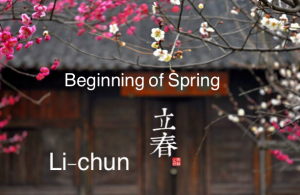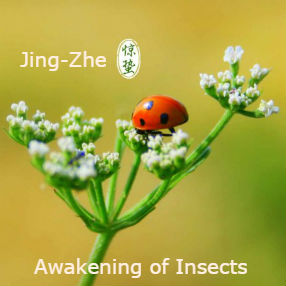
Li-chun (noun) 立春 (Chinese) Beginning of Spring (1st solar term), literally in Chinese “Li” 立 = stand, “Chun” 春 = Spring.
Example:
In the ancient Chinese calendar also known as the “agriculture calendar”, Li-chun is one of the 24 solar terms which later spread to many Asian countries. Li-chun is the 1st solar term and first intercalating month (initial). Li-chun begins when the Sun reaches the celestial longitude of 315° and ends when it reaches the longitude of 330°. Li-chun more often refers in particular to the day when the Sun is exactly at the celestial longitude of 315°. In the Gregorian calendar, Li-chun usually begins around February 4 and ends around February 18 (February 19 East Asia time). Li-chun is also the beginning of a Sexagenary cycle (gan-zhi 干支). In Chinese “Qi-hou” 气候 means weather, while “Qi” 气 is referred to as “jie-qi” 节气 the 24 solar terms in a year, whereas “hou” means “period” in a “jie-qi”. There are three periods 三候 in a “jie-qi”. Each period 候 is scheduled for 5 days and there are 15 days in a “jie-qi”.
In Chinese tradition, Li-chun shows the beginning of Spring and it is the first solar term of the 24 terms. Li-chun is, like the other 23 solar terms, divided into 3 periods 三候 with a total of fifteen days. During the first 5 days period 东风解冻, “When the east wind thaws the ice, on the second-period 蜇虫始振; locust starts to vibrate, and the third-period 鱼陟负冰; fish smashes the ice”. It is said that at the beginning of Li-chun, the east wind warms the land. Five days after Li-chun, hibernating insects slowly awake. In the last five days, the ice in the river begins to melt, and the fish start moving up the river. At this time, there are still ice flakes that are not completely dissolved on the water’s surface. The fish are generally able to swim toward the surface of the water. During Li-chun, farmers get ready to plan their farm work such as plowing and sowing, etc.
Natural flowers, trees, birds, and animals all live and move according to a certain season. Their activities are closely related to climate change. Each period 候 in a Jie-qi 节气 is associated with a flower letter breeze 花信风. During Li-chun, the first-period flower breeze is associated with Winter Jasmine 迎春花, second with cherry blossoms 樱花, and third with Yulan magnolia 白玉兰. In addition to these three flower breezes, there are still winter daphne, orchids, caudate sweetleaf flowers, etc that bloom during Li-chun.
Since ancient times, Li-chun has been a solar term for agricultural purposes in the lunar calendar. Li-chun is still remembered and celebrated as a Chinese traditional festival.

